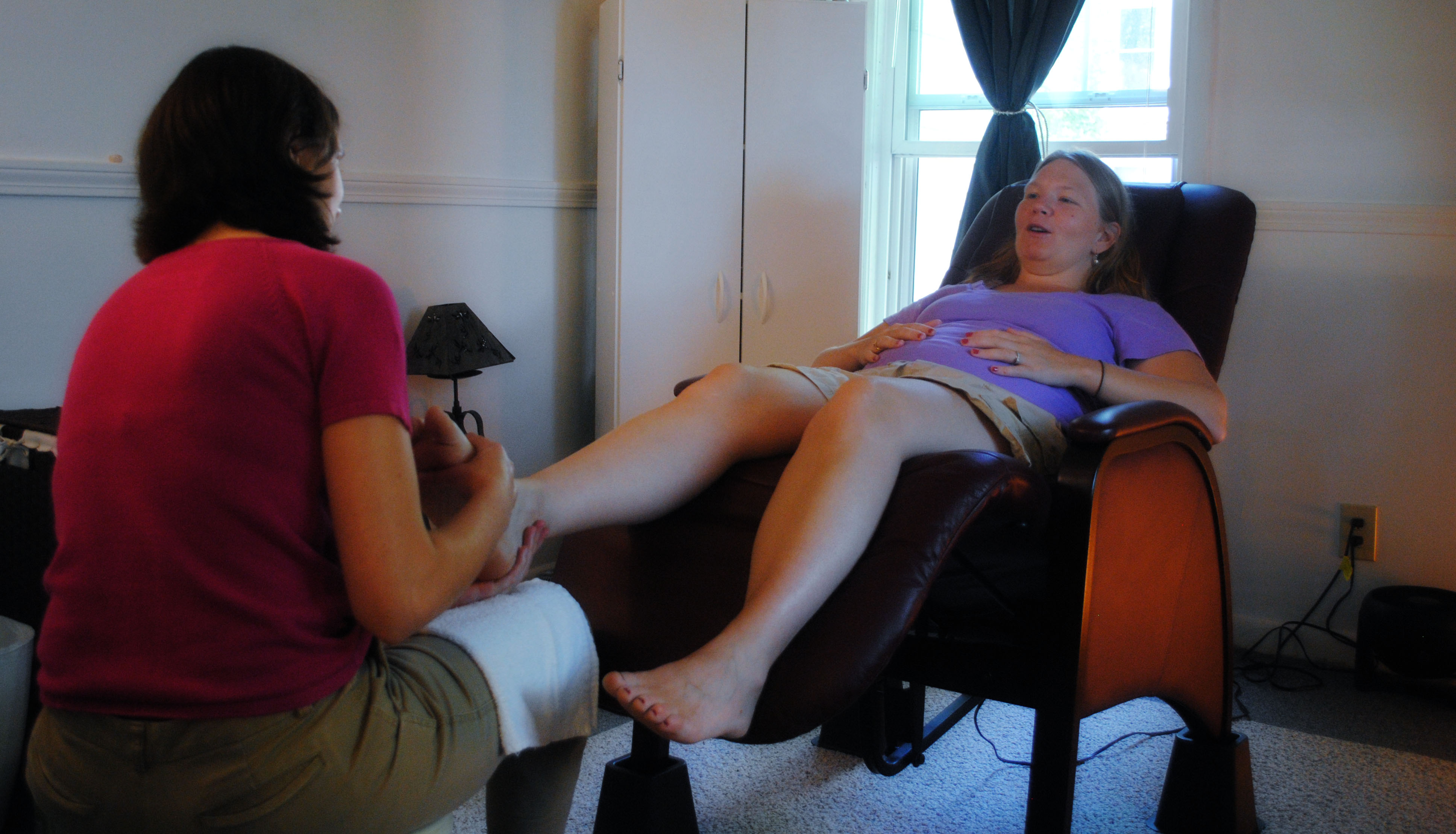Reflexology has been shown to reduce both the duration and pain of labor, eases many of the discomforts of pregnancy – headaches, back pain, heartburn, blood pressure, edema – and is well received as a deeply relaxing and comforting modality. In the age of “internet experts” in every search engine result I want to address this commonly asked question of how effective Reflexology might be for inducing labor.
My experience in the childbearing year is both personal and professional – I attended my first birth at the age of 7 and have gone on to attend over a hundred more. I’ve been practicing full-time as a Reflexologist with a specialization in women’s health for the past 15 years and have given thousands of sessions to parents-to-be. I practiced for a few years as an all-in-one Reflexology-Doula, providing sessions throughout pregnancy, attending clients at their births in hospitals and birth centers and their living rooms, and providing more sessions in the postpartum weeks and months. I’ve attended a number of labor inductions as a Reflexologist and in the capacity of Reflexology-Doula. So let’s see if we can explore that burning question: can we get labor started with a few reflex points on the feet?

Image by Harmid
What is an Induction of Labor?
Let’s start by looking at what an induction of labor entails. This medical procedure is offered by medical providers, typically an obstetrician or a midwife, and in many cases there are three main steps taken:
- Synthetic prostaglandins, like misoprostol, are introduced to the cervix via the vaginal canal – prostaglandins are naturally produced at the cervix to soften, shorten, and dilate the cervix in preparation for labor. Synthetic prostaglandins act similarly to our body-made prostaglandins and may come in the form of a gel, or a tampon-like applicator that is tucked up against the cervix and later retrieved via strings.
- Synthetic oxytocin, known as pitocin or syntocinon – this synthetic hormone is introduced to the bloodstream intravenously (IV) and is supposed to mimic the hormone called for by the hypothalamus and secreted into the bloodstream by the posterior pituitary. These glands are located in the brain and are designed specifically to receive feedback from the uterus and fetus during labor to regulate how much oxytocin is produced. Synthetic oxytocin doesn’t work in tandem with the uterus and fetus so this step of labor induction can be very challenging for the laboring parent and is prone to complications.
- Artificial rupture of membranes aka AROM – an amniotomy is performed by the provider using either their finger or a specialized tool known as an amnihook or amnicot to break the bag of waters that surrounds the baby.
The World Health Organization (WHO) recommends the following general principles related to the practice of induction of labor:
- Induction of labour should be performed only when there is a clear medical indication for it and the expected benefits outweigh its potential harms.
- In applying the recommendations, consideration must be given to the actual condition, wishes and preferences for each woman, with emphasis being placed on cervical status, the specific method of induction of labour and associated conditions such as parity and rupture of membranes.
- Induction of labour should be performed with caution since the procedure carries the risk of uterine hyperstimulation and rupture and fetal distress.
- Wherever induction of labour is carried out, facilities should be available for assessing maternal and fetal well-being.
- Women receiving oxytocin, misoprostol or other prostaglandins should never be left unattended.
- Failed induction of labour does not necessarily indicate caesarean section.
- Whenever possible, induction of labour should be carried out in facilities where caesarean section can be performed.
While in an ideal world an induction would only be performed for medical purposes – if pregnancy is no longer safe for parent and/or baby – I have seen elective inductions performed for a variety of reasons, including that of preferred scheduling by the parents-to-be or the provider. About 75% of inductions will lead to a vaginal birth, while the other 25% will lead to a surgical birth via cesarean section. Complications like I mentioned above include uterine hyperstimulation, fetal distress, and more rarely, uterine rupture. When I was practicing as a Reflexology-Doula I observed inductions following a pattern we call the cascade of intervention. Induced labor is hard work for parent and baby and since synthetic hormones don’t pass the blood-brain barrier it makes it harder for the body to play catch up with its own natural hormones to manage frequency and intensity of the contractions as well as pain sensations.
 What is Reflexology?
What is Reflexology?
Reflexology is a pressure point modality that is applied to maps that resemble the human body found on the feet, hands, and ears. Archeological findings suggest most ancient cultures had a form of foot therapy but Reflexology’s modern roots start in New England with an Ear Nose and Throat surgeon named William FitzGerald. Dr FitzGerald used these reflex maps for analgesic purposes in his practice in the early 1900s and his colleague, a physical therapist from Florida named Eunice Ingham, developed it into a therapeutic modality that is used around the globe to this day.
My clients have found Reflexology to be helpful during their pregnancies to ease aches and pains, help them achieve more restful sleep, carry their baby(ies) to term, and have a shorter labor. We’ve found Reflexology to be most beneficial when sessions are frequent in the first and third trimesters, and maintenance sessions scheduled for the second trimester. The final weeks of pregnancy usually have my clients coming weekly or twice-weekly for appointments.
Reflexology’s Role in Labor Induction
So, can Reflexology induce labor? Considering an induction of labor is a medical procedure I think the question bears reframing. Reflexology can’t make the body do something it isn’t ready or capable to do. Since an induction attempts to circumnavigate the body’s natural pattern to let labor initiate on its own I have no problem saying Reflexology can’t perform the same service. And honestly, if it could force the issue, as in a medical induction, what else could it force the body to do? Reflexology quite simply cannot force the body to end a pregnancy at any gestational stage. It is a very safe modality beloved by expectant parents, recommended by maternal providers, and practiced by trained Reflexologists around the world.
Reflexology can support the expectant parent through:
- Maintenance Reflexology – a series of sessions that are given throughout pregnancy and have been shown to reduce the need for an induction as well as shorten the time of active labor.
- Preparing for a labor induction – usually given the day or two before a scheduled induction to reduce stress and prepare the body for an induction.
- Priming for labor – an approach used in the final weeks of pregnancy intended to prepare the parent-to-be for baby’s signal to start labor.
 Maintenance Reflexology
Maintenance Reflexology
Two outspoken fans of Reflexology during pregnancy are obstetrician Gowri Motha, and midwife Denise Tiran. Motha’s book The Gentle Birth Method advises expectant parents seek out the services of a professional Reflexologist throughout their pregnancy. She writes, “Reflexology is very safe in pregnancy, and is instrumental in helping 45.5% of my mothers give birth at the optimum gestation of 40 weeks.” She lists the benefits of Reflexology: “Reduce and normalize high blood pressure, normalize low blood pressure, eliminate oedema and reduce swelling in feet and ankles, prevent heartburn, improve sleep quality, clear headaches, relieve varicose veins, clear pelvic congestion, improve lymphatic drainage, aid digestion, oxygenate the baby, help you carry your baby to term.”
Tiran’s book Reflexology in Pregnancy and Childbirth has been a resource in my practice since it was first published in 2010. She lists the aims of Reflexology in maternity care, “to enhance maternal – and, indirectly, fetal – wellbeing during pregnancy through relaxation, by restoring and maintaining physical, psychological and emotional homeostatic balance; to provide the expectant mother with opportunities for time to herself for rest and relaxation, and with a “listening ear” to allow her to express her concerns; to relieve symptoms and discomforts of pregnancy, labor and the postnatal period by promoting the mother’s innate self-healing capacity and facilitating her coping mechanisms; to prevent minor deviations from normal developing into medical/obstetric complications and to assist in reducing the severity of any complications which do arise.”
In conjunction with my own experiences working with clients in the childbearing year the experiences of these two maternity Reflexologists have led me to wish all expectant parents had access to a well qualified maternity Reflexologist during their pregnancies!
Reflexology Prior to a Labor Induction
When an induction is scheduled it can be an overwhelming experience for the parent-to-be. Most of the feedback my clients have given are in the vein of: they thought they had more time, that they would be going into labor naturally, that they have a natural birth plan in place(!!). Reflexology can be deeply supportive in the face of a medical induction, a gentle way to pause the chaos and catch one’s breath. I’ve given Reflexology sessions in L&D triage, the day before a postdates induction, and during an induction. For some clients they’ve described that session as a time of peace and comfort in the face of having to change their birth plans for a wholly different experience.
I think Reflexology is very appropriate in the days leading up to a scheduled induction to help manage feelings of anxiousness, to prepare parent and baby for labor, and to turn the dial down on stress hormones so the body’s own oxytocin can play a larger role in the medical induction.
Priming for Labor
Reflexology sessions given from about week 37 onwards are intended to support the body’s natural process of preparing to initiate labor on its own. In utero the developing fetus produces a surfactant that will help them breathe on their own after birth. When the lungs are fully developed two proteins are released into the amniotic fluid, creating a slight inflammatory response on the uterus. In turn this sets off the production of uterine hormones that play two roles: 1.) they begin to soften, shorten, and dilate the cervix, 2.) they signal the hypothalamus and pituitary in the brain to produce oxytocin to initiate uterine contractions.
As part of a feedback loop between the maternal and fetal sides, the stress hormone cortisol is elevated during pregnancy. It’s role lies in fetal development and the preparation of both parties for labor and childbirth. When additional cortisol gets heaped on though the picture changes – that fight or flight decision affects the length of the pregnancy by initiating preterm labor or delaying for a postdates labor. One interesting study looked at pregnancies following maternal psychosocial stress, “Our finding that odds of post-term birth were higher than expected among pregnancies exposed to the September 2001 terrorist attacks in late gestation provides initial support for the hypothesis that exposure to a psychosocial stress during pregnancy may result in prolonged gestation.”

Giving Sarah a Reflexology session in her second trimester
Trying Reflexology in Pregnancy
It’s been my great joy and honor to support clients in the childbearing year as a Reflexologist, as a junior midwife assistant, and as a Reflexology-Doula. While I am not actively attending births these days I have attended over a hundred and a number of those were medically induced. As a Reflexologist I have given thousands of sessions to expectant parents and seen firsthand how Reflexology supports the parent-to-be. If you’re keen on trying Reflexology I have a few recommendations for you:
- Find a qualified reflexologist – make use of membership organizations that screen folks on their directory who meet the national education standards, more on this in a bit.
- Commit to a series of sessions – Reflexology has a cumulative benefit, meaning the sessions will build on each other. While it is a lovely way to relax getting just one session won’t give a sense of the full-spectrum of this modality, it’s really not a one-and-done kind of therapy.
- Listen to your body after the session – be curious about what areas your body is triaging the session, look for changes like easier digestion, more restorative sleep, less puffiness in your extremities, feeling more connected with baby, et cetera.
Reflexology is a self-governed modality in the United States as well as in a number of other countries. There’s pros and cons to this model but it bears exploring, I’m all about consumers being able to make informed decisions about their care and that certainly goes for Reflexology. The Reflexology profession decides how a professional Reflexologist is trained, practices, and markets themselves. Using a peer system here in the States we have representatives on state and national levels through membership organizations like the Reflexology Association of America and state-level associations like the Texas Reflexology Association. We’re also one of the last bodywork modalities that uses psychometrically valid models to offer a national board exam through the American Reflexology Certification Board. All this is to say, check with the Reflexologist you’re considering working with to ensure they meet current education guidelines, are following a scope of practice, and have the experience to work with clientele. Be aware that anyone can hang out a shingle and call themselves a Reflexologist, whether they’ve attended a 200-300 hours Reflexology program, or just decided to read a book or watch a video.
I welcome your questions and comments below!









I think TCM practitioners would disagree with you concerning the possibility of Acupressure on certain points inducing labor. There is a distinct reason that we stay away from those points when a client is pregnant.
I don’t avoid these points, Amelia. Nine times out of ten they just make a client crampy and uncomfortable. Kind of like the notion of mashing on the uterus reflex. If baby isn’t ready you’re just gonna make your client uncomfortable and grumpy. 🙁
Great article which sums up that reflexology or any other modality does not induce labour but rather has the ability to create a homeostatic balance . Meaning when the womans mind and body are in balance, spontaneous labour is more likely to occur.
As an experienced research midwife, TCM acupunturist, aromatherapist and reflexologist, this is what I always explain to the women I see in my private practice.
Sadly, there will still be practitioners out there who continue giving pregnant woman misleading information because they do not understand the physiology process of childbirth or the endocrine system. Those who do understand, know that ‘messing’ with the uterus with any complementary therapy, especially reflexology should be avoided and does not induce labour.
Equally reflexology and acupressure are totally different mechanisms, either way the uterus zone should not be touched.
Hopefully they will come across your article. Well done Amy x
Thanks, Amanda for bringing your insight and expertise here.